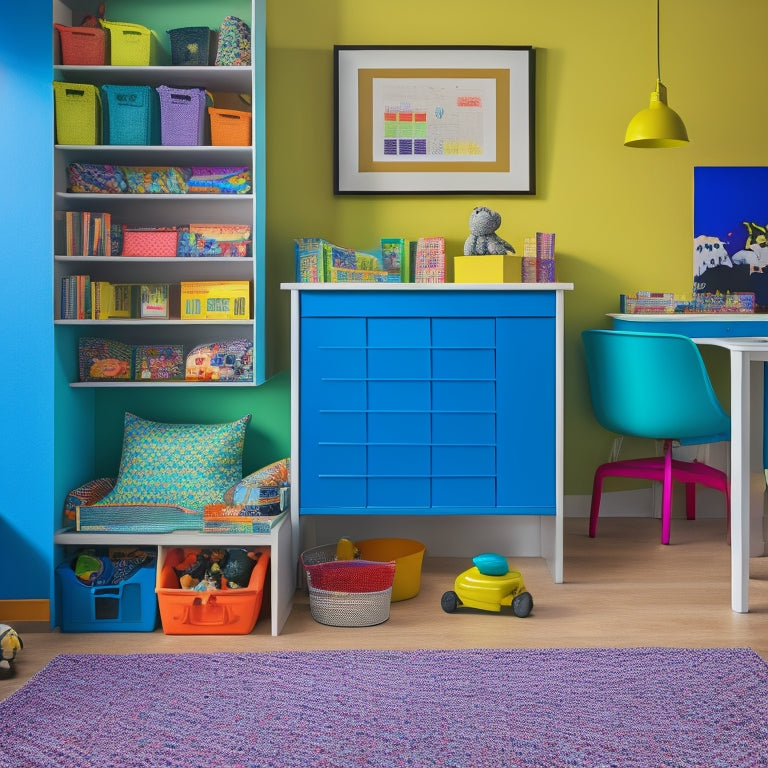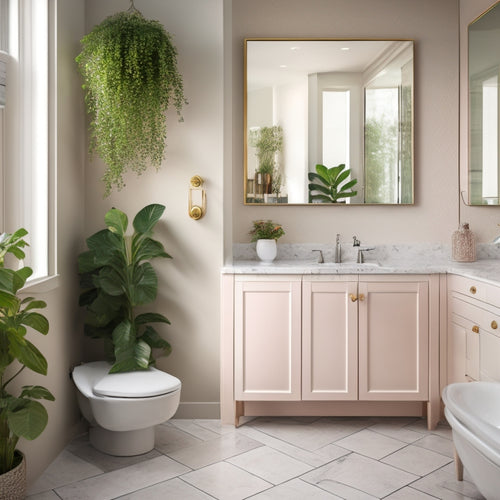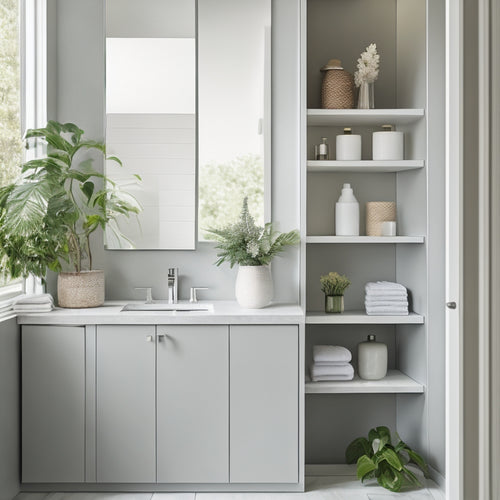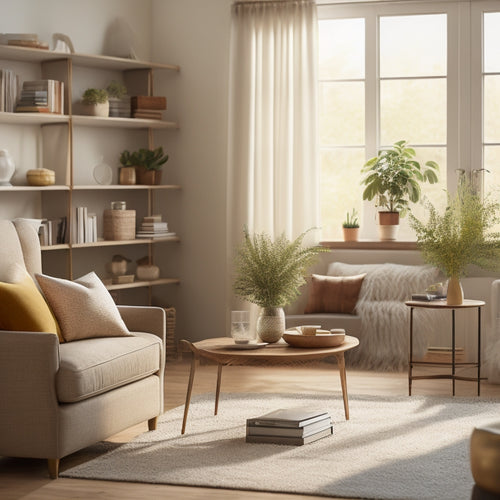
Kid-Friendly Storage Solutions for a Clutter-Free Space
Share
You're on a mission to create a kid-friendly space that's free from clutter, and that starts with assigning them their own designated storage areas and teaching them healthy habits to maintain organization. Assign towel hooks at a kid-friendly height, add personal touches with favorite themes, and make kids feel invested in keeping their area clean. Use labeled bins, color coding, and picture labels to categorize items, and prioritize easy accessibility with kid-friendly shelves. By implementing these solutions, you'll create a clutter-free space that promotes independence and responsibility in kids - and that's just the beginning of a more organized, calm, and fun environment for your little ones.
Key Takeaways
• Assign each child their own designated space in the bathroom to promote a sense of ownership and responsibility for keeping their area clean.
• Use storage bins with labels and pictures to help kids easily identify where items belong and encourage them to put things back in their place.
• Install shelves and hooks at kid-friendly heights to make it easy for them to access what they need and develop independence.
• Implement a labeling system and signage to help kids quickly identify where items are stored, promoting organization and responsibility.
• Consider the age and abilities of each child when designing storage solutions, ensuring that everything is accessible and easy to use.
Bathroom Organization Ideas for Kids
Creating a kid-friendly bathroom starts with assigning each child their own designated space, making mornings and bedtime routines more efficient and less chaotic.
This can be achieved by installing towel hooks at a kid-friendly height, making it easy for them to hang their own towels and robes.
You can also add a personal touch to each child's space by incorporating their favorite bathroom theme, such as a superhero or princess design.
This will make them feel more invested in keeping their area clean and organized.
Storage Bins for Little Ones
When it comes to storage bins for your little ones, you're probably looking for solutions that are both functional and easy to use.
You'll want to think about bins that can be labeled for easy identification, so your kids can quickly find what they need.
Labeling for Easy ID
You can easily identify the contents of storage bins by labeling them with words or pictures that your little ones can understand. This way, they can quickly find what they need and develop good habits of putting things back in their place. Labeling is an essential step in maintaining a clutter-free space, and it's essential to make it fun and engaging for your kids.
Here are some tips to make labeling a breeze:
-
Use Color Coding to categorize different types of items, such as toys, books, or art supplies.
-
Create Picture Labels that your kids can easily recognize, especially if they can't read yet.
-
Involve your kids in the labeling process, letting them help choose the labels or pictures to use.
- Keep labels simple and concise, using words or images that are easy to understand.
Sizes for Any Space
From compact cubes to large containers, selecting the right-sized storage bins for your little ones guarantees a perfect fit for any play area or shelf. This is especially important when working with compact layouts, where every inch counts. By choosing bins that fit snugly into your space, you can maximize storage capacity while keeping the area clutter-free.
| Container Size | Ideal For | Benefits |
|---|---|---|
| Small (10x10x10) | Toy blocks, puzzles | Perfect for tiny toys and easy to move around |
| Medium (18x12x12) | Stuffed animals, books | Versatile size for a variety of items, fits on most shelves |
| Large (24x18x18) | Dress-up clothes, art supplies | Ample space for bulky items, great for play areas |
When selecting storage bins, consider flexible furniture that can adapt to your child's changing needs. Look for bins with removable labels, so you can easily update the contents as your child grows. By choosing the right-sized storage bins, you'll create a space that's both functional and fun for your little ones.
Kid-Friendly Shelf Solutions
When creating a kid-friendly shelf solution, you'll want to prioritize easy accessibility, ensuring your little ones can reach their belongings without a struggle.
You'll also need to take into account the ideal shelf height, considering your child's age and abilities.
Easy Accessibility Shelves
Easy-to-reach shelves with sturdy, grip-friendly handles make it simple for kids to grab their favorite toys, books, or craft supplies without needing a stool or adult assistance. This is especially important for kids who are still developing their fine motor skills and may struggle with complex storage systems.
By incorporating easy accessibility shelves into your kid-friendly storage solutions, you can:
-
Encourage kids to put away their toys and supplies, promoting a sense of responsibility and independence
-
Reduce clutter and mess, making it easier to find what they need
-
Foster a sense of autonomy, as kids can access their belongings without needing help
- Choose flexible shelves with adjustable heights to accommodate kids of different ages and abilities, ensuring that everyone can reach their favorite items
With easy accessibility shelves, you can create a clutter-free space that empowers kids to take charge of their belongings and develop important life skills.
Shelf Height Matters
You'll want to take into account the age and ability of your child when determining the ideal shelf height, as it can greatly impact their ability to access and engage with their belongings independently. Age appropriateness is important here, as shelves that are too high or too low can be frustrating and even dangerous.
For toddlers, shelves should be around 2-3 feet off the ground, allowing them to easily reach and explore. For older kids, shelves can be slightly higher, around 3-4 feet, promoting independence while still being accessible.
When determining the perfect shelf height, consider your child's measurement guidelines. A good rule of thumb is to place shelves at a height that allows your child to comfortably reach the middle shelf without straining or using a stool. This encourages independence and makes it easy for them to put away toys and books.
Labeling for Clarity
By assigning a clear label to each shelf or bin, you can help your child quickly identify where items belong, making cleanup a breeze and encouraging them to take ownership of their belongings. Labels serve as a visual reminder of what belongs in each space, reducing clutter and confusion.
Here are some effective labeling strategies to try:
-
Use Color Coding: Assign a specific color to each category of items (e.g., toys, books, clothes) to create a visual system that's easy to follow.
-
Create Photo Labels: Use pictures or icons to label bins and shelves, especially for younger children who may not be able to read yet.
-
Keep labels Simple and Concise: Use short phrases or single words to avoid overwhelming your child with too much information.
- Make labels Fun and Engaging: Use colorful stickers, stencils, or decorative fonts to make labeling a fun and creative activity for your child.
Clutter-Free Countertops Made Easy
What's taking up valuable real estate on your countertops, and how can you reclaim that space for meal prep and quality time with your family? It's time to create clutter-free countertops that make cooking and socializing a breeze.
Start by designating countertop zones for specific tasks, such as a prep zone for food preparation and a coffee zone for your morning brew. This will help you stay organized and focused on the task at hand.
Next, tackle surface decluttering by removing anything that's not essential to your daily routine. Be ruthless – if you haven't used it in the past month, it's probably safe to store it away or donate it.
Once you've cleared the clutter, assign a home for each item, ensuring everything has a designated spot. This will prevent clutter from building up again in the future.
Bathroom Toy Storage Ideas
Between bath time and getting ready in the morning, the bathroom can quickly become a toy-strewn zone, but with a few clever storage ideas, you can corral the chaos and keep your little ones' favorite bath toys and accessories within easy reach.
By implementing a few simple storage solutions, you can maintain a sense of calm during bath routines and make the most of your bathroom space. Here are some ideas to get you started:
-
Use suction cups or adhesive hooks to hang bath toys, like rubber ducks or squirt toys, on the side of the tub or shower wall, keeping them dry and organized.
-
Invest in a shower caddy or basket to store washcloths, soap, and shampoo, keeping them off the floor and within reach.
-
Utilize the space under your bathroom sink by installing a slide-out drawer or shelf to store bath toys, lotions, and other bathroom essentials.
- Implement a toy rotation system, where you switch out bath toys every few weeks, to keep things fresh and exciting for your little ones, while preventing overwhelm and clutter.
Cabinet Organization Made Simple
You'll be surprised at how much more efficient your morning routine becomes when you can easily find what you need in your cabinets.
A cluttered cabinet can be overwhelming, especially when you're trying to get the kids ready for school. To simplify your cabinet organization, start by using Adjustable Dividers to separate items into categories. This will help you and your kids quickly identify where everything is.
Next, consider installing Soft Close cabinet doors and drawers. These will prevent loud bangs and slams, creating a more peaceful morning atmosphere. You can also use baskets, bins, and shelves to store items like snacks, cleaning supplies, and kitchen utensils.
Labeling each basket or bin will help your kids develop good habits and maintain the organization system. By implementing these simple cabinet organization strategies, you'll be on your way to a clutter-free space that makes mornings a breeze.
Easy Access Bathroom Storage
Create a bathroom storage system that works for your family by installing shelves, hooks, or a recessed medicine cabinet near the sink to keep essentials within easy reach. This will encourage your kids to maintain their bathroom routine without making a mess. By providing easy access to toiletries, towels, and other bathroom essentials, you're teaching your kids independence and responsibility.
Here are some ideas to maximize your bathroom storage:
-
Install bathroom caddies or shower stations near the shower area to store soap, shampoo, and conditioner.
-
Use over-the-toilet storage units to keep extra toilet paper, towels, and other essentials.
-
Consider a pedestal sink organizer to store small items like toothbrushes, toothpaste, and Q-tips.
- Add a bathroom cart or shelf near the sink to store towels, washcloths, and other bathroom necessities.
Labeling and Signage for Kids
Labeling and signage can help your kids quickly identify where items belong, making it easier for them to put things back in their proper place and maintain a sense of organization and responsibility. By using clear and concise labels, you can create a system that's easy for your kids to follow. Consider using color coding to categorize items, such as labeling toys, books, and clothes with different colored stickers or labels. This visual reminder will help your kids quickly identify where items belong, making it easier for them to put things back.
Visual reminders, such as pictures or icons, can also be used to help your kids remember what's inside a container or on a shelf. For example, you can add a picture of a toy car to a bin labeled 'Toy Cars' or a picture of a book to a shelf labeled 'Favorite Books.' By using a combination of color coding and visual reminders, you can create a labeling system that's easy for your kids to understand and follow.
With clear labels and signs, your kids will be more likely to maintain their space and develop good habits from an early age.
Frequently Asked Questions
How Do I Encourage My Kids to Maintain Their Organized Space?
To encourage your kids to maintain their organized space, establish morning routines that include tidying up, and use positive reinforcement by praising their efforts, creating a sense of ownership and responsibility.
Can Storage Solutions Be Adapted for Children With Special Needs?
You can adapt storage solutions for children with special needs by incorporating sensory integration strategies and adaptive tools, such as tactile labels or specialized bins, to create a tailored system that accommodates their unique requirements.
Are There Any Eco-Friendly Storage Options Available for Kids?
You're probably thinking, "Eco-friendly storage for kids? How quaint." But, yes, you can find sustainable materials and recycled products that'll make you feel good about storing those toys and books.
How Often Should I Rotate Toys and Supplies to Prevent Clutter?
You should rotate toys and supplies every 2-3 months to maintain a clutter-free space, adopting a seasonal swap approach to keep things fresh, and adjusting your toy refresh rate as your child's interests evolve.
Can I Customize Storage Solutions to Fit My Child's Personality?
You'll be thrilled to know that, yes, you can customize storage solutions to fit your child's personality! Try color coding and using personalized labels to make it fun and engaging, allowing your child to take ownership of their space.
Conclusion
You've made it! By implementing these kid-friendly storage solutions, you've taken the first step towards a clutter-free bathroom.
Did you know that 84% of parents say clutter negatively impacts their mental health? By creating a tidy space, you're not only promoting a sense of calm but also teaching your kids valuable organizational skills.
Now, take a deep breath and enjoy the serenity of your newly organized bathroom!
Related Posts
-

Stylish Corner Cabinet Ideas for Bathrooms
Looking to enhance your bathroom with stylish corner cabinets? You can maximize space and improve aesthetics at the s...
-

Modern Bathroom Cabinetry for Small Bathrooms
When designing modern bathroom cabinetry for small spaces, your focus should be on maximizing storage while embracing...
-

Transform Your Life With Organized Home PLR
By transforming your living space with organized home PLR, you'll awaken a profound shift in mental clarity, energy, ...


